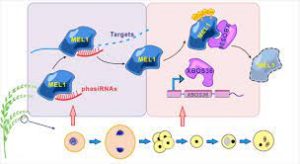Meiosis arrested at leptotenene1 (MEL1) plays a role in the meiosis of germ cells by binding to germ cell-specific phasirnas. MEL1 protein expression is regulated in time and space and is rapidly cleared after meiosis. But why does MEL1 need to be precisely regulated during germ cell development? How is it regulated?

Recently, Professor Chen Yueqin / Zhang Yuchan, associate professor of School of life sciences, Sun Yat-sen University, found that the continuous expression of MEL1 after meiosis would cause the abnormal development of pollen mother cell tetrad and early microspore, resulting in the decline of rice fertility. The rapid degradation of MEL1 by the proteasome ubiquitination pathway after meiosis is necessary to ensure the development of rice pollen. In addition, a novel E3 ubiquitin ligase xbos36 was identified to mediate MEL1 clearance in monocotyledons. Xbos36 knockout or MEL1 overexpression can destroy MEL1 homeostasis in germ cells, resulting in off-target cleavage of phasirna target genes, thereby inhibiting microspore development and maturation. In this study, E3 ubiquitin ligase was identified to regulate the degradation of reproductive specific AGO protein, and the significance of stable regulation of ago protein on pollen development was analyzed.
The research achievement “Ubiquitin dependent Argonaute protein MEL1 degradation is essential for rice sporogenesis and phasirna target regulation” was published online in The Plant Cell journal.
Reference
Jian-Ping Lian, Yu-Wei Yang, Rui-Rui He, et al, Ubiquitin-dependent Argonauteprotein MEL1 degradation is essential for rice sporogenesis and phasiRNA target regulation, The Plant Cell, 2021;, koab138, https://doi.org/10.1093/plcell/koab138.